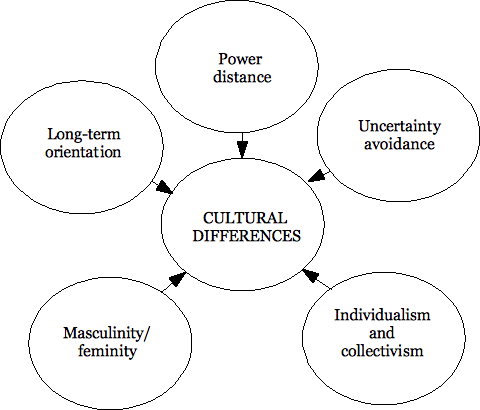| << Chapter < Page | Chapter >> Page > |
Businesses with diverse cultural backgrounds must maintain an environment suited for every constituent so that the objectives of the business can be efficiently met. Installing cultural diversity training programs can help accomplish this by defining what cultural intelligence is, teaching employees to accept and work effectively with others from different cultural backgrounds, and taking advantage of advice from those who have cross-cultural experience.
Cultures can either be distinguished according to descriptive characteristics or they can be broken up into value categories, which are essentially dimensions of national culture.
Geert Hofstede, a leading expert in cultural values classification, developed a model of five dimensions of natural culture that help to explain basic value differences in culture. The model distinguishes cultures according to the following five different dimensions:

The Power Distance Index (PDI) focuses on the degree of equality, or inequality, between people in the country's society. The Individualism (IDV) focuses on the degree the society reinforces individual or collective, achievement and interpersonal relationships. The Masculinity (MAS) focuses on the degree the society reinforces, or does not reinforce, the traditional masculine work role model of male achievement, control, and power. The Uncertainty Avoidance Index (UAI) focuses on the level of tolerance for uncertainty and ambiguity within the society. These dimensions are measured on a scale from 0 to 100, include 75 countries or regions, and scores are determined by “high” or “low” rankings within each category.
Cultural values determine the way people think and behave. International marketers must understand many subtle differences that may affect the way their marketing is made and perceived in foreign markets. One medium in which many such differences reside is language. Because language is a reflection of culture, some words cannot be cross-culturally translated, which implies that it is often better to have local copywriters write and translate marketing and advertising content to avoid cultural misunderstandings. Because of this phenomenon, global advertising, which is a main component of global marketing, often relies on symbol recognition to convey meaning in their ads, instead of words.
The approach to discussing culture, as it relates to global marketing, in most textbooks is a three-pronged approach. First, the concept of culture is defined, second, the various components of culture are identified, and third, vivid examples of cultural differences are provided. The dire consequences of firms not taking these differences into account are invariably described, as adherence to local culture is considered one of the most important, if not the most important, components of success in international marketing (Hofstede, 1996).
Managers of businesses that conduct operations in an increasingly global environment face a dilemma when selecting and applying ethics to decisions in cross-cultural settings. Although ethical values may be similar across cultures in many cases, the application of those values to certain situations may vary. Ethics can be described as the science of human duty. It is upon the ethical standards of a person that judges whether or not an action is right or wrong.
Before a company does business across borders, it must first decide what its motivation is regarding ethical conduct, which will determine what kind of behavior is to be expected from employees.

Notification Switch
Would you like to follow the 'Business fundamentals' conversation and receive update notifications?